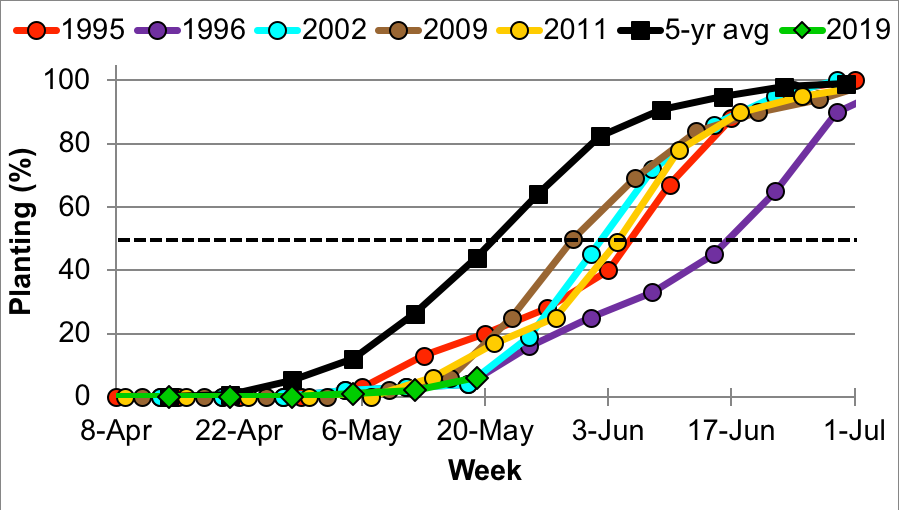Soybean planting progress (or the lack there of) for Indiana and much of the Midwest is one of the slowest on record. Indiana soybeans normally reach 50% planted by May 20th, but we are only at 6% by the same period. Over the past 25 years of records, we have experience similar delays in 2011, 2009, 2002, 1996 and 1995 (Figure 1). Four of those five years reached 50% planted by May 30 to June 5, while 1996 did not reach 50% planted until about June 20th.

Figure 1. Late planting progress for Indiana over the past 25 years of records. As of May 19, Indiana has 6% of its soybeans planted (USDA-NASS).
Planting date is major factor in setting the yield potential of soybean. We typically see our greatest yields with late April to early May planting, which are long passed. In a given year, the yield potential will often decline ~0.4 bu/ac/day beyond mid-May.
It is difficult to predict the final yield of 2019, but let’s look at the past years at the state level (Figure 2). We typically go below the yield trend potential in the last week of May. However, soybeans do have an amazing ability to attain respectable yields under stressful conditions. In the late planting years alone, yields were only 5.5 to 10% below yield trends with 1996 being the largest departure. Whereas, Indiana soybean yield in 2009 was ~2% above yield trend. Your upcoming management decisions and the rest of the growing season will dictate the final outcome.

Figure 2. Indiana soybean departure from yield trend as compared to 50% planting date over the past 25 years (USDA-NASS). The drought of 2012 was omitted from the regression, and late planting years of 2011, 2009, 2002, 1996, and 1995 are noted.
Current field conditions and the forecast does not look to promising for major progress in the last week of May. With this trajectory, I would like to provide some guidelines as we will likely be planting a lot of soybeans in June. You need to consider your seeding rates, row width, and maturity group. Soybeans trip their reproductive trigger (flowering) as the day length shortens, which occurs much quicker with delayed plantings.
SEEDING RATE – Planting in the first weeks of June require ~10% increase in seeding rates (10,000 to 15,000 seed/acre increments for each week of delay). The higher seeding rates will help to facilitate quicker row closure and higher pod height with fewer days to flowering.
My starting recommendations for normal planting operations in April and May are: 120,000 to 140,000 seeds/acre for planters (15 to 30”), 140,000 to 160,000 seeds/acre for air seeders (~15”), and 160,000 to 180,000 seeds/acre.
If you typically plant 140,000 seeds/acre in 15-inch rows, you need to bump the seeding rate to 150,000 to 155,000 seeds/acre in the first week of June then to 165,000 to 170,000 seeds/acre in the second week of June, so forth and so on. Soybeans will produce fewer main-stem nodes (attachment points of trifoliates and ultimately pods) as planting is delayed, so the increasing seeding rates will also help to overcome the shortfall in node production.
ROW WIDTH – If you plant 30-inch rows, you need to look into the possibility of planting narrower rows with the limited time to flowering. We typically see a yield advantage of 5 to 10% for soybeans planted in narrow rows (15 inches or less) compared to 30-inch rows, and this difference will be even more prominent in late planting situations. Wide rows (30-inch) take nearly 25 days longer and 40 days longer to canopy compared to 15-inch and 7.5-inch rows, respectively. This delay will certainly decrease the yield potential as canopy closure would occur well after reproductive initiation.
MATURITY GROUP – Full-season varieties for your respective regions should be planted until June 15 for the northern quarter, June 20 for the central half, and June 25 for the southern quarter of Indiana. Varieties should be dropped a half maturity group after these dates and planted for another two weeks before we consider other alternatives. If you are in a very late planting situation, I suggest back-dating 90 days from the typical fall freeze in your region to determine if you have enough growing season to mature a soybean crop. My hope is that you will not need to make that determination, but I will follow up if discussion is needed.
Table 1. General dates to maintain full-season variety planting based on geography followed by timelines for maturity group switches.



